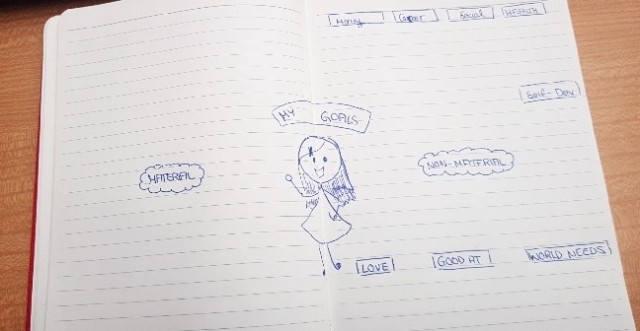Today I really wondered what to call the post. If I learned something from the last days stopping procrastination is not possible. At least not for me. Maybe you have this amazing thing called self-control. If you have, I am envious! :’) At times I am tired, at times I just don’t have enough time. And my to do list grows on a daily basis. There is literally no end to it. The more I start, the more there is to do. In any case I have achieved a lot the last days trying out the methods listed below. Rather than calling the post how to stop procrastination, which is way too negative anyways, I’d like to call it how to get stuff done. Down there you will find 25 tips and tricks to get things done:
Before you start with the preparation, going back to the last blog post, eat that frog. Get the worst task done. Then you can indulge in planning and reading!
Are you back? Nice to see you again! Before you get started a decent plan can really help with reducing procrastination. How can you stop procrastination, when you don’t even have an overview of what to do?
Preparation:
- Create a master-list of all the things to do. You can add the action steps you previously prepared for achieving your goal. Brainstorm everything that comes to mind. If it helps you to draw, draw it.
- Now break those tasks up into monthly junks. Make the steps as small as possible.
- As Marie Forleo explained verberize the list. Your to-dos should start with easy, one step verbs. It is important that the tasks are really clear. E.g.
- go to the supermarket
- buy bread
- Use the 13 Folder method. You can use real folders or what I like to use is OneNote. As shown below create a folder for each month. And a to-do list for each day. Not only is the tool nice to organize your to dos, but you can also see the progress you make. The other folder is my master list, which includes all tasks.
- Don’t put too many to dos on your list. Stay below 8 points and aim to achieve the top three. Definitely at least the first one.
- Organize the list with your MIT (most important task) on top. OneNote has many useful tools for that. If you want some more organization within the tasks you can use the ABCDE method, as explained in the last post. Or you can organize them chronologically.
- Schedule meetings (including friends and family) and important dates in your calendar. Also schedule junks of uninterrupted work time, when you do the tasks.
- Each night before you go to sleep review the next days to dos. Have the priorities changed? Do you have to add/ remove any tasks? Is your MIT clear?
- Generally, work on being in decent shape. Drink, eat and sleep enough and look out for your health. It’s easier to tackle a task, when you haven’t pulled an all-nighter and barely can open your eyes. Moreover, the better and more positive you feel the less you procrastinate.
- Is your work environment cluttered? Are there many distractions, such as the TV open magazines? Open YouTube pages? Remove all distractions. Better yet prepare a workspace/ room/ coffee shop, that is specifically used for working. Try to have all necessary materials on hand. By the end of the day clean your workspace and prepare for the next days to dos.
Time to take action:
If you struggle with starting, the following tricks might help.
- Play your power song when you start working. Decide on one song that makes you feel motivated. Every time you hear the song your brain knows it’s time to work.
- Commit to working on your MIT for 5 minutes for the day. Once you have achieved that and you really don’t feel like continuing stop. You promised to yourself 5 minutes. And don’t feel bad about it. Goal achieved. Better than the last days.
- Start with small bites. Maybe just 1 word a day, one jog, one word. Don’t think about what tasks will follow. Every time thoughts about future tasks arise, empty your mind.
- Start with the easiest part. If you have a day you really struggle with starting, try doing the easiest part of your MIT first. Once you are in the flow continuing gets easier.
- Make it fun. Now you probably wonder how to make an awful task fun. You have to work out? Watch your favorite TV show on the side.
- Don’t try for perfect. Target 80 percent perfect. Worrying too much about perfections might cause more procrastination.
- Distract yourself from the feeling of not wanting to do something.
- Just sit and do the task until the uncomfortable feeling passes.
- Smile while you feel uncomfortable or use power gestures. If you smile your brain will start thinking, if I smile it must be fun.
- Use the 5 seconds rule by Mel Robbins. Simple, but yet efficient. Don’t give yourself enough time to think that you don’t want to do something. Count don’t from 5, and just do it.
- Every time you don’t want to do something tell yourself the mantra: Just do it!
- Use the pareto principle. Work 25 minutes on your task and then take a 5-minute break. Then start again. An app I really like for that purpose is Forest. You set a time, during which you won’t use your phone. During that time a tree grows. If you use your phone before the time is over your tree dies.
- When you get tense try relaxation methods, such as breathing. Another method is to tense up your muscles for 5 seconds than relax, tense, relax. Do that until you are relaxed.
- Don’t let tasks pile up. That sounds pretty obvious, but often we collect a heap of tasks and get overhelmed.
- Imagine yourself doing the task. Think about feeling happy about the task. Do the task in your brain over and over again, until it doesn’t make you feel uncomfortable anymore.
After finishing your task:
- Review what went well. What didn’t go so well.
- Standardize the process.
- Review the tasks for tomorrow.
- Clean your workspace.
- Take a deep breath.
- Dance a little success dance. And congratulate yourself for a job well done.
Some suggested tips I found, that haven’t worked for me, or I haven’t tried yet:
- Making procrastination more painful, like giving your friend money if you fail.
- Rewarding yourself when you finish something. (Why reward myself later when procrastination is already like a reward in advance?)
- Learn skills you lack in order to avoid future procrastination.
- Forgive yourself for procrastination. (eh yeah..)
- Have an accountability buddy.
- Make plans and goals public.
- Work according to your inner schedule.
- Ask yourself why you avoid the task.
- Prepare an awareness bracelet. Each time you try to procrastinate turn it around. Write down what your reason for procrastination was. Sometimes being aware of what you are doing is already a start.


 There in the center that’s me :’)
There in the center that’s me :’)